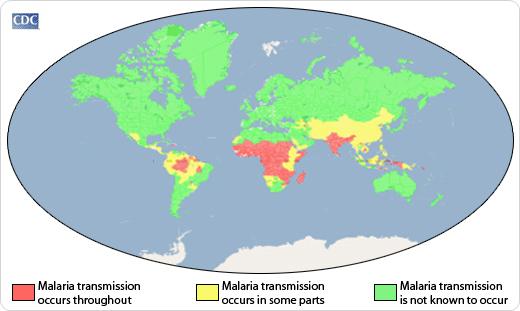Malaria has been recognised as a severe and life-threatening illness for thousands of years. It still is one of the most common diseases affecting humans worldwide. The major impact of the disease is almost entirely on the developing countries, with the heaviest burden in Africa. Almost half of the total world population is exposed to the risk of contracting malaria.
Economic burden of malaria
Along with direct health cost there is a severe economic burden of the disease in terms of lost days of work. In fact malaria is thought to take off 1.3% from the economic growth of some African countries. In some of the most severely affected countries, it accounts for 40% of public health expenditure, 30-50% of inpatient admissions, and 50% of outpatient visits. It affects developing countries in more ways than one including determent of tourism.
How many people does malaria affect?
There were an estimated 219 million cases of malaria (154–289 million) and 660 000 deaths (range 610 000–971 000) in 2010. Of total numbers 80% of estimated malaria deaths occur in just 14 countries and approximately 80% of estimated cases occur in 17 countries.
The Democratic Republic of the Congo and Nigeria account for over 40% of the estimated total of malaria deaths globally. The Democratic Republic of the Congo, India and Nigeria account for 40% of estimated malaria cases.
Estimated malaria mortality rates are highest in countries with a lower GNI per capita. Countries with higher proportions of their population living in poverty (less than US$ 1.25 per person per day) have higher mortality rates from malaria.
Of the deaths a large proportion was young children in sub-Saharan Africa. This is the most vulnerable group affected with the condition. In areas with high transmission, the most vulnerable groups are young children. These children are vulnerable because they have not developed immunity to malaria yet. Pregnant women are also at risk because their immunity has been decreased by pregnancy.
Who does malaria mainly affect?
Malaria affects mainly poor tropical and subtropical areas of the world. Where the disease is endemic it is the leading cause of illness and death.
Africa has several factors that make it high risk for malaria. Some of these include very efficient mosquito (Anopheles gambiae) responsible for transmission, predominant parasite species is Plasmodium falciparum that leads to more severe malaria, warm and humid climate that allows transmission to occur year round as well as lack of resources and poor socio-economic conditions that prevents malaria control efforts. Other areas that are at risk include some countries in South America and South Asia.
Summary
To summarize, malaria is the leading cause of death and disease in many developing countries. According to the World Health Organization’s World Malaria Report 2011 and the Global Malaria Action Plan, 3.3 billion people worldwide live in areas at risk of malaria transmission in 106 countries and territories.
In 2012 malaria led to 216 million clinical episodes, and 655,000 deaths. An estimated 91% of deaths in 2010 were in the African Region, followed by 6% in the South-East Asian Region and 3% in the Eastern Mediterranean Region (3%). 86% of all deaths worldwide are children.

Sources
- http://www.nhs.uk/Conditions/Malaria/Pages/Introduction.aspx
- http://www.bbc.co.uk/health/physical_health/conditions/malaria1.shtml
- http://www.niaid.nih.gov/topics/malaria/documents/malaria.pdf
- http://www.cdc.gov/malaria/malaria_worldwide/index.html
- http://www.cdc.gov/malaria/malaria_worldwide/impact.html
- www.who.int/…/wmr2012_summary_and_keypoint.pdf
Further Reading
- All Malaria Content
- What is Malaria?
- Malaria Causes
- Malaria Mechanism
- Malaria Diagnosis
Last Updated: Feb 27, 2019

Written by
Dr. Ananya Mandal
Dr. Ananya Mandal is a doctor by profession, lecturer by vocation and a medical writer by passion. She specialized in Clinical Pharmacology after her bachelor's (MBBS). For her, health communication is not just writing complicated reviews for professionals but making medical knowledge understandable and available to the general public as well.
Source: Read Full Article
